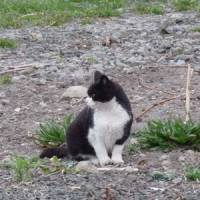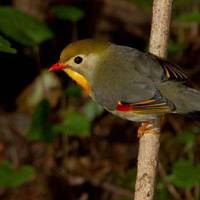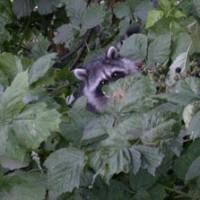I could scarcely make out the small songbird moving secretively through the undergrowth in the gloom of the dark forest. Its calls were barely familiar to me and seemed so out of context that I didn't recognize them at all at first.
Then, by a process of elimination, I checked off all the species that I knew occurred in the laurel forests surrounding Lake Miike in southern Kyushu — a process that led me to the conclusion that this must be something outside of those parameters.
Finally, a brief glimpse confirmed my suspicions that it was a relative newcomer to the forests of Japan — a leiothrix. That sparked a recollection that I had made my own first record of this species in Japan years earlier, in February 1994, in Oita Prefecture.
Despite the gloom as dusk neared on that winter's day in Kyushu, however, the bird's bright waxy-red bill, yellow throat and orange gorgette were striking. If only it had stayed long enough for me to enjoy a detailed view, but it — and, I suspect, several fellows — had flitted away through the sasa (dwarf bamboo). They were gone in an instant and without trace.
Nevertheless, I knew that what I had glimpsed was a true native of southern China and the Himalayas — not of Japan. Yet somehow this small, colorful bird had found its way into the very different environment of Japan — a stranger in a strange land.
I have looked for leiothrixes repeatedly since, but never with the degree of success of reader/photographer John Wright, who has supplied this marvelous accompanying photograph of a leiothrix taken in Kyushu.
Having escaped, or been released from captivity, the red-billed leiothrix (known to science as Leiothrix lutea) has found deciduous broadleaved forests with an understory, or "shrub-layer," of dwarf bamboo much to its liking in southern and western Japan. It is a bamboo specialist and there are seemingly few if any other such birds in Japan, so the leiothrix appears to have found a vacant niche to spread into.
Or has it?
So often our understanding of natural habitats and the way in which they function is simplistic, or even entirely lacking. We often find out the hard way when the consequences of alien introductions begin to make themselves felt.
Two people who have investigated the ecology of this new species to the avifauna of Japan are H. E. Amano and K. Eguchi, who described their findings in a paper in the journal Ornithological Science in 2002 titled "Foraging niches of introduced Red-billed Leiothrix and native species in Japan."
The leiothrix, which is a common species in the international cage-bird trade, was accidentally (or perhaps deliberately) released here by bird fanciers who gave scant thought to the impact of another alien species in the native environment. It has increased rapidly in numbers and its range has also expanded considerably since it was introduced into the wild in Japan in the early 1980s.
Whenever a non-native species becomes established, though, the immediate concerns relate to whether it might become a significant predator on any native species or whether it might outcompete native species for local resources, ranging from food to nesting sites.
Amano and Eguchi have shown that, here in Japan, leiothrixes tend to forage in the lower levels of the vegetation, particularly among bamboo. They live in a behavioral zone that places them as intermediates between the foraging levels of the well-known Japanese bush warbler and various other species of small woodland bird such as the willow tit, varied tit and eastern great tit.
Since arriving in the wild some 30 years ago, many naturalized populations have formed in central and southwestern Japan. However, they seem to have done especially well in Kyushu, where they have increased remarkably, raising the ugly possibility of them competing with native species in their new home.
Each species occupies its own ecological niche, but where several species share habitat, they segregate — each avoiding the other — and so may occupy a narrower niche or one that has shifted slightly in response to competition. Any shift in foraging space, or foraging techniques, is important evidence of what's known as interspecific interference competition.
It turns out, though, that leiothrixes utilize a unique foraging space that species native to Japan rarely use. Forest habitats appear visually to be layered, with vegetation occurring in distinct bands from the canopy down to the herb layer. Species dependent on those plants — whether insects, birds, mammals or reptiles — tend to occur in bands, too, with some of them specializing in just one part of the forest structure. Nonetheless, there is always a tendency for some degree of overlap.
In fact, it appears that the red-billed leiothrix forages mainly about four meters above the ground, which is above the zone preferred by the Japanese bush warbler and below that favored by species such as varied or coal tits, willow tits and eastern great tits.
In fact, the red-billed leiothrix seems most like the Japanese bush warbler, in that it strongly favors using areas of the forest where dwarf bamboo predominates in the lower layer.
Foraging techniques between species also vary, but many in these zones gather food by gleaning while hanging upside down or while in flight. The leiothrix, however, has rather short wings relative to its body weight, and a rather large and dumpy body, making it less suited to gleaning among leaves for its prey.
Instead, it has long legs and a relatively wide tail with outward curving outermost feathers that may give it an edge when maneuvring quickly by jumping — which seems to be its preferred way of foraging for its aerial insect food just above the dwarf bamboo. Consequently, differences in its microhabitat within the forest, and in its foraging methods, may effectively segregate it from native species.
By comparing data on the way various small-bird species forage, and what they forage on in areas with and without leiothrix, Amano and Eguchi were able to conclude that native species seemed not to have undergone shifts in the use of their foraging space as a result of the presence of leiothrixes. They suggest, therefore, that it is probably not a serious competitor with them.
Could it be that, in the leiothrix, we have gained a new species for the Japanese avifauna without long-term ecological consequences impacting native species?
This has certainly not been the case with the introduction of the North American raccoon into Hokkaido, where it now competes with farmers for their crops and native animals and birds for their eggs and young — as well as for precious natural cavities in trees. Indeed, it now also competes with feral domestic cats, which roam wild as voracious predators on native species.
Neither does an absence of ecological consequences mark out the almost ubiquitous red-eared slider, which seems to be in almost every large pond I have investigated in southern and western Japan — perhaps competing there with adverse consequences for a range of native turtles and terrapins.
Introducing aliens may indeed add color and diversity to our natural environment, but more often than not it ends in ecological disaster.
Mark Brazil is a naturalist and author who leads wildlife excursions around Japan by land and sea. His latest book is "Field Guide to the Birds of East Asia" (A & C Black), and his earlier "A Birdwatcher's Guide to Japan" is a standard in the field. To simply and speedily obtain copies of either title, contact him at [email protected] or via his website www.wildwatchjapan.com







